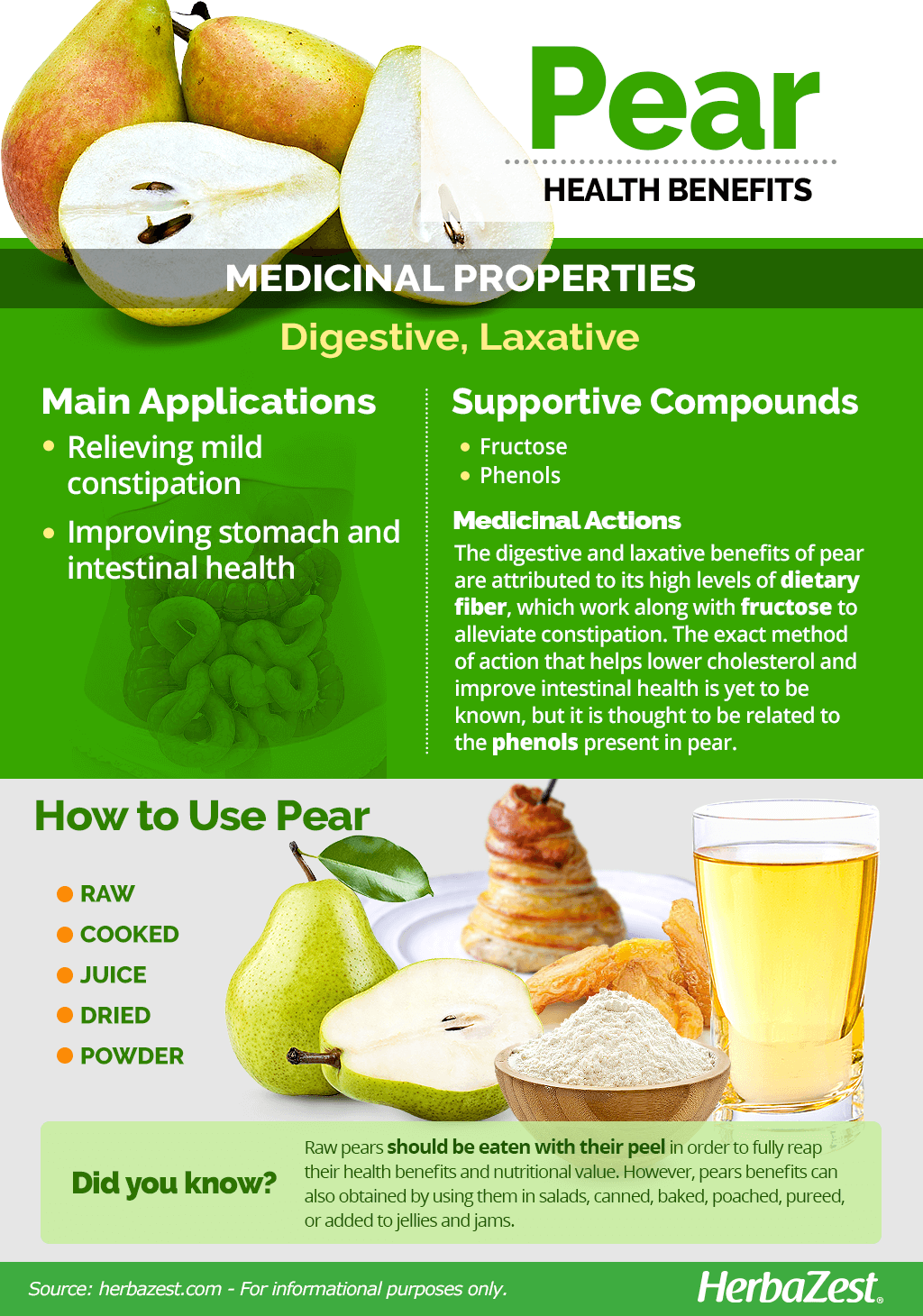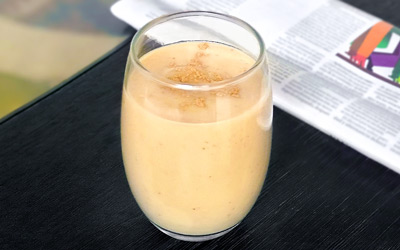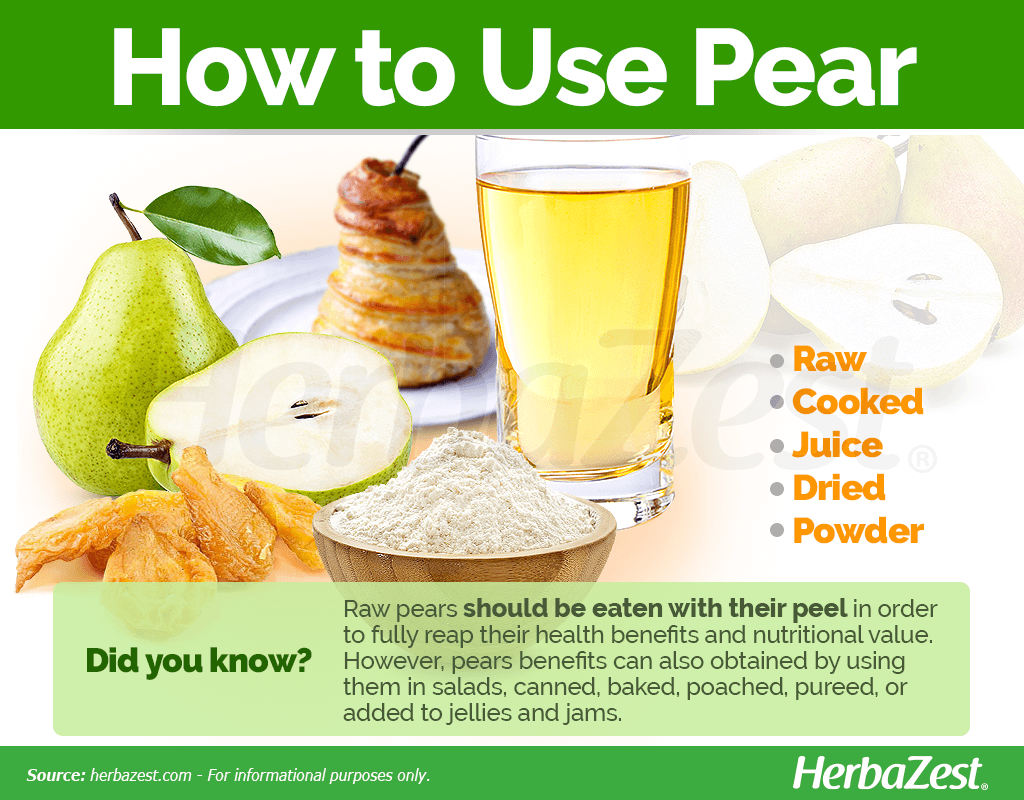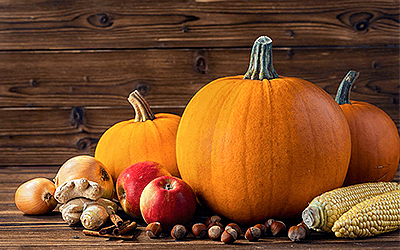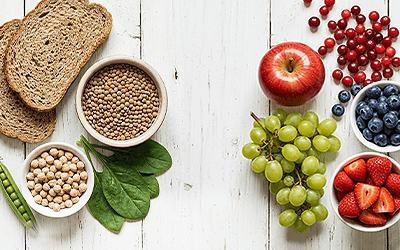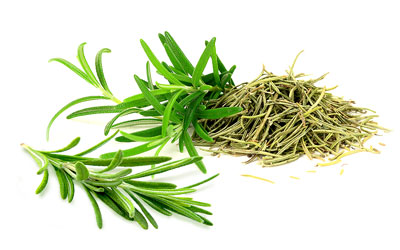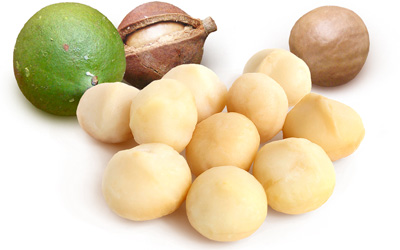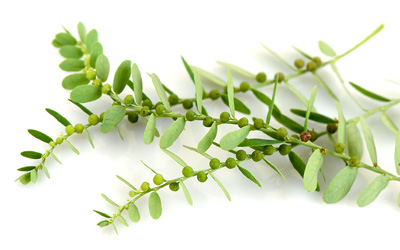Pears have been revered since ancient times and were referred to as "a gift of the gods" by the ancient Greek poet Homer. The early Romans also enjoyed the fruit and developed dozens of varieties that they spread across Europe. Today, there are over 3,000 pear varieties in existence and the fruit is enjoyed worldwide.
Pear Medicinal Properties
Health Benefits of Pear
Pears are more often eaten for their taste and nutritional value than for their medicinal benefits, but research has shown pear health benefits to be quite useful for:
Relieving mild constipation. The most well-known pear benefits come from its mild laxative properties, which are quite helpful for promoting intestinal motility.
Improving stomach and intestinal health. Research has shown that pear properties can protect against ulcers, and they may be essential in developing healthy gut bacteria.
Additionally, pears can reduce cholesterol levels.
How it Works
Pears are high in both fructose and dietary fiber, both of which play a role in the laxative properties of these juicy fruits. Fiber is known to help reduce constipation, and fructose plays a role in this process as well. The exact method of action that helps to lower cholesterol and improve intestinal health is not yet known, but it is thought to be related to the phenols present in pear.
Herbs like psyllium, senna, and tamarind also provide laxative effects, while yacon has shown prebiotic actions that promote a healthy gut flora.
Pear Side Effects
Pears are generally safe when taken in normal amounts, even during pregnancy and lactation; however, they may cause diarrhea if taken in large amounts because of their high fiber content, and some sensitive people may experience allergic reactions, including itching, swelling, rashes, digestive upset, or even anaphylaxis.
Pear Cautions
Pear causes no known medical interactions.
- Medicinal action Digestive, Laxative
- Key constituents Fructose, phenols
- Ways to use Food, Juiced, Powder, Dried
- Medicinal rating (2) Minorly useful plant
- Safety ranking Safe
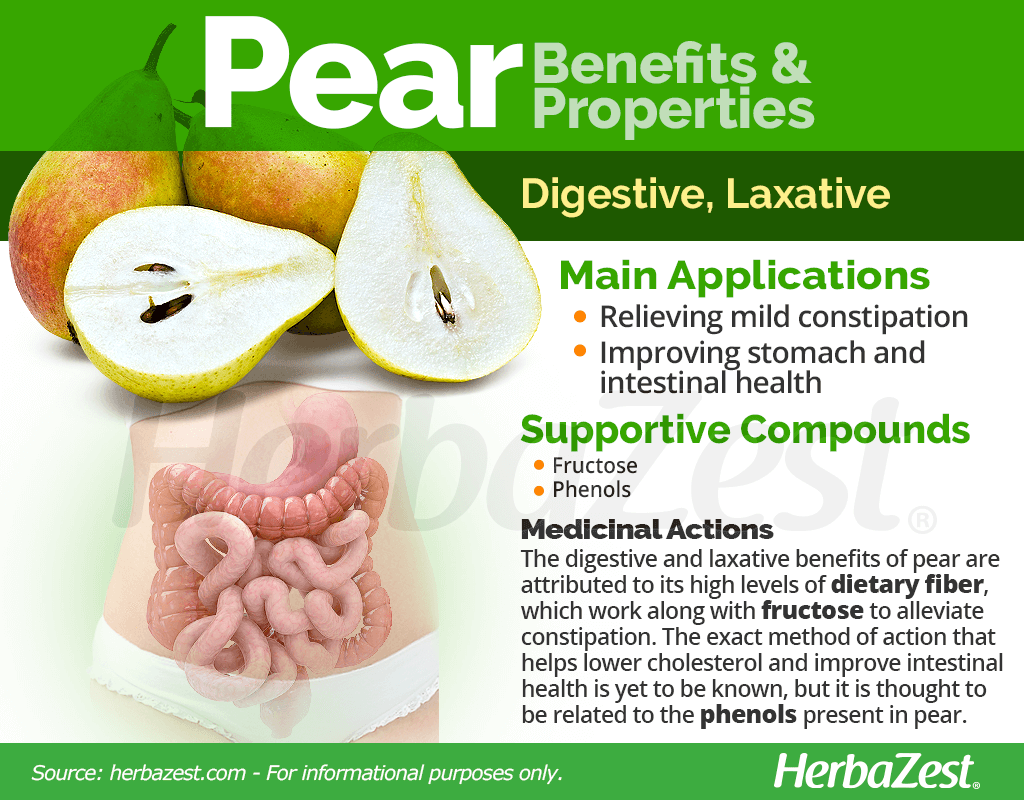
Pear Nutrition
Most of pear's health benefits hail from its richness in dietary fiber, which is necessary for optimal digestive functions as well as for controlling sugar metabolism, lowering blood pressure, and preventing the build up of cholesterol within the arteries.
The nutritional value of pears lies in a variety of essential nutrients that, even in small quantities, contribute to support various bodily functions. Pears provide good amounts of copper, a mineral that helps in the production of blood cells, along with supporting the health of blood vessels, nerves, immune system, and bones. On the other hand, reasonable levels of potassium contribute to blood pressure control by counteracting the effects of sodium and helping relax blood vessel walls.
Furthermore, pears are a fair source of vitamin C, essential for calcium and iron absorption as well as for healthy skin and immunity. They also provide adequate amounts of vitamin K, necessary for coagulation and bone density.
A small pear (148 g) provide 84 calories as well as 8 and 18% of the daily value for carbohydrates and dietary fiber.
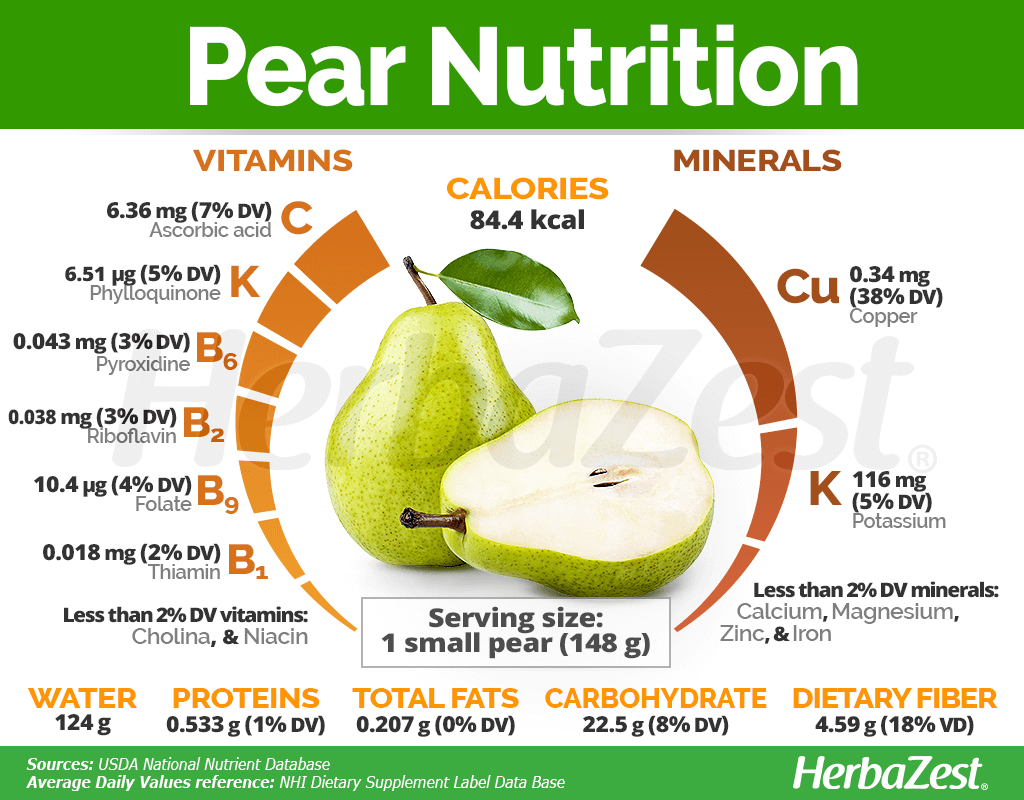
How to Consume Pear
Pear is most often eaten either alone or as a culinary ingredient. It can be used in salads, canned, baked, poached, pureed, or added to jellies and jams. It is also commonly used in beverages, including alcoholic drinks like ciders.
Natural Forms
Raw. Pears are most commonly eaten raw, which provides all three of its health benefits - relieving constipation, lowering cholesterol, and improving digestion. In order to fully reap pear benefits and nutritional benefits, the fruit should be eaten with the peel still on.
Cooked. Whether baked, poached or in pureed, the benefits of pear for constipation can be obtained even when consumed cooked, although exposure to heat reduces its content of vitamin C.
Juice. Due to its fructose content, pear juice can also relieve constipation and help improve digestive health. This effect can be enhanced if the dietary fiber of the fruit is included.
Dry. In this way, the pears can be consumed as a healthy snack, low in calories, or as an infusion. In any of these ways, dehydrated pear helps improve digestion.
Powder. Mostly for culinary use, pear powder retains all flavor and benefits of fresh pears, except for the water content.
- Edible parts Fruit
- Edible uses Beverage
- Taste Sweet
Growing
Pear is a perennial plant that can grow across different temperate climates, although it does require some specific conditions in order to reach its best potential. It is best to choose a self-pollinating variety to increase the chances of fruit production.
Growing Guidelines
Pear is generally propagated by seeds, but its seeds require long exposure to cold in order to break dormancy, for at least 1,000 hours at a minimum of 45°F (7°C).
Plant pear in neutral pH, loamy and moist soils. To promote better drainage, the seeds may be planted on a slope.
Pear requires full sun and plenty of space to grow to maturity.
Pear trees are significantly more tolerant to cold weather than to heat, resisting temperatures below 0°F (-18°C).
The trees should be regularly pruned, but the best pruning method is dependent on the type of pear being grown.
Fertilizer is usually not necessary, but mulch may be beneficial. Weeds and other grass should not grow up to the base, so anything growing too close to the tree's trunk should be removed.
Pear trees generally bloom during March or April.
Pear is susceptible to be damaged by fire blight, leaf spot, pear scab, and sooty blotch.
- Pests that attack the pear tree include moths, pear psyllas, aphids, and spider mites.
- Life cycle Perennial
- Harvested parts Fruit
- Light requirements Full sun
- Soil Medium (loam)
- Soil pH 6.6 – 7.3 (Neutral)
- Growing habitat Cool temperate regions, Temperate climates
- Planting time Early spring, Spring
- Potential insect pests Aphids, Mites, Moths
- Potential diseases Leaf spot, Bacterial blight
Additional Information
Plant Biology
This broad-headed perennial tree, which can reach heights of up to 43 feet (13 m), is cultivated in all temperate-zone countries of both hemispheres. Depending on the variety, the pear plant can also be a shrub, but this is less common. The leaves are round in shape and have wedge-shaped bases. They can grow up to 5 inches (12 cm) long and appear around the same time as the scented, white flowers. However, there are some non-flowering varieties of pear that still produce fruit.
Classification
The common pear, or Pyrus communis, is a member of the Rosaceae family, otherwise known as the rose family, which contains over 4,200 known flowering species, notably including almond (Prunus dulcis), apple (Malus domestica), blackberry (Rubus fruticosus), cherry (Prunus spp.), and hawthorn (Crataegus monogyna).
Cultivars and Related Species of Pear
Over the course of history, different cultivars of the pear fruit have been cultivated through selective breeding. Among them, the most widely available varieties in the U.S. and Western Europe are green and red 'Anjou' and 'Bartlett' pears, as well as 'Starcrimson', 'Concorde', and 'Forelle' pears.
In addition, many more hybrids can be found through crossing Pyrus communis with its close relatives. The main types of pears are the Oriental pear (P. serotina) and the Asian pear (P. pyrifolia).
Historical Information
Common pears are thought to have developed from plants growing natively in Europe and Northern Asia. They were popular among the ancient Greeks and Romans, although they were used in drinks and cooked dishes rather than eaten raw, since the ancient varieties of pear were less palatable raw. However, through breeding, pears were made safe to eat raw and became a popular dessert fruit. They were brought to America in 1797, and continue to be popular worldwide today.
Economic Data
Pear is an important ingredient in many cuisines and is thus an important economic crop. Three-quarters of all cultivated pears are grown in Asia, and the world's largest producer is China; it produced a massive 18 million tons in 2014. The United States and Italy are also large producers of the fruit.
Popular Beliefs
Pears are thought to have been an important religious symbol in ancient Russian religions, in which tree worship was common. Pear trees were thought to house spirits.
Giving pears as gifts is often considered bad luck in China. This is because the word for pear in Chinese sounds very similar to the word for breaking up, and giving somebody a pear - especially in a romantic relationship - could be taken as a message that the giver wants to end the relationship.
Several towns in California, notably Kelseyville and Courtland, regularly hold pear festivals to celebrate the growing of the fruit. These fairs are great places to find pear-flavored food and drink that will not be available elsewhere.
Other Uses
Timber. Pear's wood is a preferred type of wood in high-quality woodwork for products like musical instruments, kitchen utensils, and furniture.
Fuel. The aroma of pear's wood is also valued, and used as firewood when smoking meat or tobacco.
Pear is already popular for its sweet, tart taste, but its many health benefits - especially its digestive benefits and ability to lower cholesterol - make it a valuable medicinal herb.
- Other uses Fuel, Furniture/carpentry, Timber
Sources
- Journal of the Federation of American Societies for Experimental Biology, Health benefits of pear
- University of Minnesota, Growing pears in the home garden
- Washington State University, History of Pears
- FAOSTAT, Pears
- Journal of Agricultural and Food Chemistry, Composition of phenolic compounds in a Portuguese pear (Pyrus communis L. var. S. Bartolomeu) and changes after sun-drying, 2002
